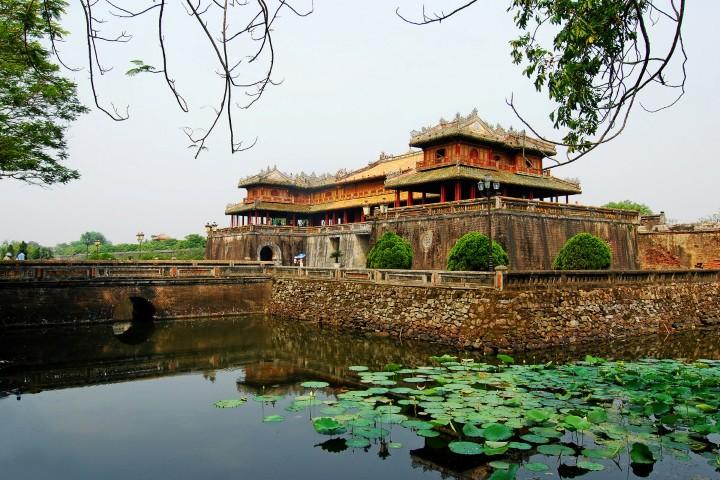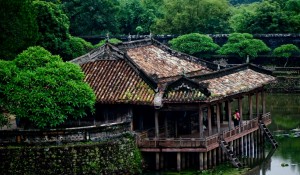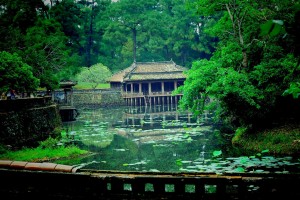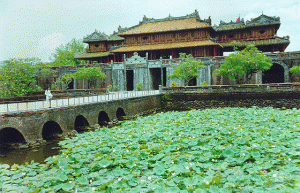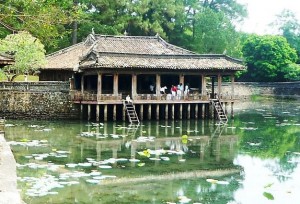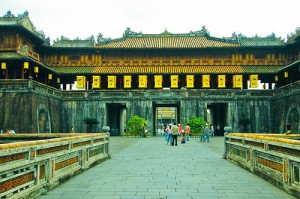Geography
Complex of Hue relics is situated along Perfume river’s banks of Hue city and surrounding areas of Thua Thien Hue province. Hue city is a center of culture, politics, and economy of the province, the ancient national capital under the reign of Nguyen family from 1802 to 1945.
History
Since 1306, after the marriage of Huyen Tran princess and Che Man (Champa King), Chau O and Chau Ly territories include Quang Tri, Thua Thien Hue, and a part of the North of Quang Nam today were named “Thuan Hoa”. In the second half of century XV, under Le Thanh Tong dynasty, the name of “Hue” appeared for the first time. Nguyen Lord’s residence was settled at Kim Long (Hue) in 1636 and then moved to Phu Xuan, Noi Hue at present. In the first years of century XVIII, Phu Xuan was center of culture, politics, and economy of Southern Vietnam and imperial capital of Tay Son dynasty from 1788 to 1801.
Since 1802 to 1945, Hue was national capital under the reign of 13 Nguyen Kings. In this time, many valuable cultural architectural works were constructed, typically Hue Capital Citadel, especially the Imperial City (including 253 constructions), 7 Royal tomb compound of 9 kings of the Nguyen Dynasty, the Esplanade of Nam Giao, the Ho Quyen arena and the Hon Chen Temple.
Cultural value
On the North bank of Perfume’ s river is a system of architectures symbolizing power of Nguyen centralization regime including : Hue Capital Citadel, Royal Citadel and Forbidden Citadel.They were nested and well-matched arrangement on a vertical axis running along from the South to the North direction. The system of ramparts is an outstanding example of harmonious combination between Eastern and European style. The constructions were located in a stunning natural landscape with plenty of available elements which were so natural that they claimed to be integral parts of Hue Capital Citadel. They are Ngu Binh mountain, Huong Giang river, Gia Vien and Boc Thanh dunes…
Hoang Thanh (Royal Citadel) was surrounded by a square-shaped wall which is more than 600 m long for each side and 4 gates of which Ngo Mon gate is often considered symbol of ancient capital, where important events of the dynasty took place. Royal Citadel contains Tu Cam Thanh (Forbidden Citadel) which was reserved for Emperor and his family.
Than Dao path, running through 3 citadels from Perfume river’s bank marked with important constructions of Hue Citadel with most important buildings of Hue: Nghinh Luong Dinh, Phu Van Lau, Ky Dai, Ngo Mon, Thai Hoa palace, Can Chan palace, Can Thanh palace, Khon Thai, Kien Trung… At both sides of the path is hundreds of architectural buildings with different sizes arranged and interlaced with plants and trees that brings visitors relaxed feelings.
In the distance, to the west of the Capital Citadel, along the Perfume River, situated the famous royal tombs and temples, masterpieces in landscape architecture which is totally distinctly Vietnamese feature.
Each tomb reflects the life and personality of emperors. The magnificence of Gia Long’s tomb built in the immense landscape of mountains and jungles representing the spirit of a general in war; the symmetry and majesty of Minh Mang’s tomb combiners both man-made and natural mountains and lakes and reveals the powerful will and solemn nature of a talented politician who was also an orderly poet; the peaceful and sombre qualities of Thieu Tri’s tomb reflects the innermost feelings of an outstanding poet who made few achievements in political life; the romance and poetic atmosphere of Tu Duc’s tomb evoke the elegant and subtle tendency of a poet rather than the strong characteristic of a politician.
Besides, the destinations make up to the beauty of Hue ancient capital including: Perfume River, Ngu Binh Mountain, Thien Mu Pagoda, Bach Ma Mountain, the Thuan An and Lang Co Beaches.
At the 17th session of World Heritage Committee taking place in Colombia from 6 to 11 December 1999, UNESCO decided to recognize complex of Hue relics as World Cultural Heritage. This was an big event in Vietnam’s history. It was the first Vietnamese attraction recorded in the list of World Heritage, confirming global value of complex of Hue relics.
